Institute for Private Enterprise
| Home page | Speeches |
Economic Society
(Victorian Branch)
The Case For Further
Deregulation Of The
Labour Market
2 December 1998
NOTE: This paper contains some of the conclusions from a report with the same title presented to the Council of Federal and State Labour Ministers on 27th November 1988.
Introduction
While this report includes some recommendations for reform of labour market regulation, it is much more concerned to expose the serious flaws in the main rationales of such regulation and in the arguments used to oppose deregulation. It particularly addresses what the OECD recently described as "the central issue dividing the more comprehensive reformers and the less comprehensive" - that is, "differences in judgement about potential conflicts between better labour market performance and concerns for equity and social cohesion." The report effectively argues that such conflicts need not exist: a deregulated labour market can co-exist with government intervention through the social security system without damaging social cohesion, although unless such intervention is carefully targeted it will have adverse effects on employment.
Australians have come almost to take for granted the vast array of conditions imposed by third parties on businesses even though they undermine the basic function of management and are contrary to sound management principles. There are over 100,000 pages of documentation in the form of awards, orders and recommendations regulating workplaces yet there is argument about the requirement in the Workplace Relations Act 1996 to "simplify" awards to cover only 20 matters. In reality, all those matters could be satisfactorily determined by workplace bargaining, as is increasingly happening through Australian Workplace Agreements approved by the alternative authority, the Employment Advocate.
Inequality in Bargaining Power
Let me come first to the major flaws in the perceived need to equalise bargaining power through third party intervention.
For a start, the labour market is subject to the same economic forces of demand and supply as other markets and in our large, relatively open economy there is no general, natural tendency for monopsony to arise under deregulated market conditions. Australia has nearly 700,000 businesses and the natural distribution of bargaining power does not necessarily favour their owners. Moreover, all employees nowadays have alternative income sources.
Second, while deregulation would reduce the influence of trade unions, this should not lead to a lower share of national income going to wages. Competition limits the rate of profits and the remainder of national income must go to employee wages or the self-employed. The income share of labour in the less regulated US market has tended to increase.
Third, the bargaining parameters have been fundamentally altered by the transformation in the economic and social structure over the past twenty five years. The growth in the services sector, in educational qualifications and in shareholdings has increasingly replaced the "them and us" attitude with acceptance of a mutual interest in establishing a cooperative workplace.
Fourth, bargaining services are available through the private sector relatively cheaply. However, to overcome information asymmetries and undue transactions costs the AIRC could be converted to a voluntary body providing subsidised advisory services.
Comparative Wage Justice & The US Example
The second major flaw in regulation justification is the perceived need to provide comparative wage justice, and to ensure that Australia does not develop a US style labour market with a more unequal income distribution and a perceived under-class of "working poor."
One problem is that the Australian regulatory system has not, in fact, delivered comparative wage justice . Let me mention a few indicators. Chart 1 shows a declining real level of minimum wages since the 1970s; OECD data indicates that, whereas the Australian dispersion of earnings has been widening since the 1970s, it has not in the majority of OECD countries; the ACTU’s own submission to the April 1998 living wage case shows a similar widening in earnings dispersion; eleven out 24 OECD countries have a more egalitarian distribution of earnings thanAustralia ; finally, the proportion of "working poor" in the Australian labour market - 7-8 per cent - is similar to that in the much maligned US market. In short, the Commission has not been meeting one of its own prime objectives.
Chart 1
Minimum Real Rates of Pay (1989/90 = 100)

Note: Minimum real rates of pay up to 1981/82; thereafter award rates of pay deflated by the CPI.
Sources: For 1949/50-1981/82: Reserve Bank of Australia, Australian Economic Statistics 1949-50 to 1994-95, Table 4.17, June 1996 (Occasional Paper No. 8). For 1982/83-1996/97, ABS, Award Rates of Pay Indices, Australia (Cat. No. 6312.0); it is assumed that minimum wages moved in line with award rates in this period.
In reality, it is overwhelmingly the social security system not the wage regulatory system which has been protecting real incomes of those stuck at the bottom end. In fact, households in the bottom quintile of the income scale receive more than half of their income from net government cash benefits (see Table 1 below).
Second, suggestions by Gregory that the growth in low-paid jobs has not been more restricted in Australia than in the US are contradicted by the much higher proportions of the US working age population in employment and in low paid jobs. If we had the same proportion of our working age population employed as the US, we would have another 900,000 employed. Of course, with our more generous social security system and different work culture, it is unlikely that we would reach US employment rates. But we might aspire to UK or New Zealand rates, which would add another 500,000 jobs.
(1993-94 $ per week)

Source: A.Harding, "The Suffering Middle: Trends in Income Inequality in Australia, 1982 to 1993-94", Australian Economic Review, Vol.30, No.4, 1997, Table 5.
Incidentally, in assessing labour market performance it is important to look at both employment and unemployment. While a few OECD countries have lower unemployment rates than the US, only three - Norway, Iceland and Switzerland - also have higher employment rates.
Moreover, the notion that the US labour market is largely providing low-paid, poor quality jobs in the service sector is wrong. It is true that average wages in US manufacturing are about 8 per cent higher than in services. But the ‘gap’ has narrowed markedly over the past thirty years and, as Chart 2 shows, the distribution of earnings in US services is similar to that in manufacturing. In any event, Australia now has almost as large a services sector as the US.

NOTE: Data for the services industry excludes workers in private households.
The distribution of earnings is similar for services and mnufacturing, suggesting that the notion is overly simplistic that services is "low wage" and manufacturing is "high wage"
The third flaw in the comparative wage justice approach is that, although it cannot be proved that greater wage flexibility adds to employment, there is very considerable support for such a proposition. Even Card & Krueger stated recently that "if the minimum wage is raised too much, we will see job losses; there is a tipping point". During a recent press conference in Canberra, the respected US authority on minimum wages and employment, Professor Daniel Hamermesh stated:
"In my mind the international evidence is quite, quite clear despite some views to the contrary and I think it applies rather well to Australia and indeed it applies I think with more force to Australia than to most other places"
The reason it applies with more force to Australia is that our minimum wage of about $10 per hour is almost 50 per cent of average weekly earnings, significantly higher than the 35-40 per cent of average wages in the US and Canada. Given this relatively high proportion of average earnings, Card and Krueger would likely recommend a lowering here.
Fourth, major qualifications need to be made to analyses that purport to show that US wage earners have not benefited from the higher employment levels and that there has been a growing inequality in US labour market outcomes. For one thing, it is scarcely inequitable that the growth in compensation per employee has been slower than the growth in compensation per head due to the more competitive US labour market.
US earnings data significantly understates the growth in living standards of US employees because inflation in the US has been overstated by at least half a per cent pa and because large benefits provided by employers are not included. Using family incomes, and adjusting for inflation over-statement, those families at the bottom end appear to have experienced stable real incomes since the late 1970s. Further, while inequality has increased when measured by incomes, the better indicator of living standards is consumption. Measures of inequality based on consumption reveal little change since the early 1970s.
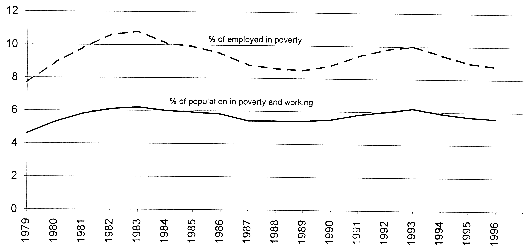
Sources: US Bureau of Census; US Bureau of Labor Statistics.
As to the infamous "working poor", Chart 3 above shows that the proportion of US employees so categorised has remained stable at around 8-9 per cent since the early 1980s. By contrast, in Australia it appears to have at least doubled. In any event, as elsewhere, the majority of low-paid US workers move up the income scale.
In short, the detailed workings out of the US labour market at the bottom end are considerably less "inequitable" than commonly portrayed. It is scarcely surprising that, with a much higher proportion in employment, there is wider dispersion of earnings there.
Fifth, even though a considerable proportion of the low-paid do remain ‘stuck’ at the bottom end, there are considerable objections to trying to help them through the wage regulatory system.
One is that wage regulation may prevent desirable changes in dispersion, such as to encourage needed increases in the supply of skilled labour or from breaking down trade union monopolies. Further, if account is not taken of differences in the quality of labour, employment will be discouraged. Australia appears less worse off in literacy skills at the bottom end than some less regulated labour markets and our "natural" dispersion in a deregulated market is therefore likely to be narrower.
We certainly have much smaller minority groups than in the US, where almost half of those in poverty are from such groups. Yet Australia has a relatively larger proportion of its population in poverty than the US, using a similar poverty line.
‘Equity’ can only be assessed by analysing the possible causes (and effects) of different earnings distributions, whether domestically or internationally. The test of inequity is not whether there is inequality of income but whether that reflects unfair practices. Assessments also need to encompass the possible effects on incomes and choices available to consumers, employers and the unemployed as well as on incomes of the employed. For example, lower growth in wages at the bottom end would benefit consumers and hence real incomes of all lower income groups, as well as those prepared to work for less but who are unjustly being denied the opportunity to do so.
Using the wage regulatory system as an income redistribution mechanism is also an inefficient means of delivering "social justice". The low paid include married women who are second income earners in a household and inexperienced young people. Moreover, as Chart 4 below shows, the majority are living in households in the upper half of the income scale while the unemployed are predominantly at the bottom end. It is clearly both irrational and inequitable to be keeping wages up for the low-paid.
The appropriate distribution of income involves subjective issues that governments should determine at a political level and the AIRC should not be a social welfare judge. If it is considered politically necessary to have a minimum wage, Federal and State Governments should set it after assessing both social security benefits and labour market conditions in the various States. Each State should have a separate minimum and a published estimate of the likely adverse employment effects.
The bottom line surely is that it is better both economically and socially to have ‘working poor’ than ‘unemployed poor.’ In the unlikely event that deregulation led to a large widening in earnings dispersion, and if that was not offset automatically through adjustments in means tested social security, an earned income tax credit could top up those categories of low wage earners unable to achieve a ‘socially acceptable’ income.
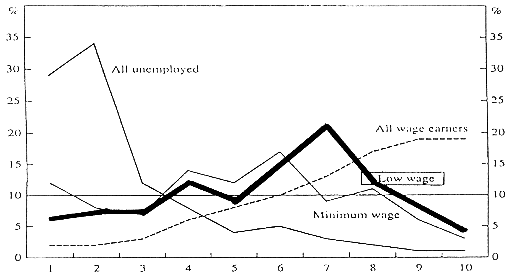
Preventing Wage Surges
A third flawed rationale for regulation is that a centralised regulatory system can help prevent wage surges. This is surely falsified by Australia’s disastrous experiences with such surges. Moreover, even accepting that the Accord was the principal constraint on wages growth in the 1980s (which I do not), all labour market players agree that the Accord experience should not be repeated.
Most importantly, the new role of the Reserve Bank in targeting low inflation represents a major institutional and policy change that undermines any argument for retaining the AIRC to prevent wage surges.
Ensuring Basic Community Standards Are Met
A fourth flawed rationale is that regulation is needed to ensure that various perceived community standards are met.
However, let us take first the prescribed working week of 38 hours. In fact, a significant proportion of people work more than that and the prescription is really only a way of setting hourly rates for ‘overtime’. Flexible hours of work and annual leave arrangements are increasingly being negotiated by employers and employees under enterprise and individual agreements.
Second, we have the attempt to provide job security by regulating dismissals. But empirical studies show that such regulation is positively correlated with the unemployment rate in OECD countries. We also know that there has been no significant change in average job tenures in Australia since the 1980s; that a majority of Australian job leavers do so voluntarily; and that an increasing proportion of the workforce work as self-employed contractors. Overseas, the less regulated labour markets actually have longer average job tenures than here and the OECD has concluded that ‘jobs seem as stable in the 1990s as they were in the 1980s.’
Job security is much more a function of stable macro-economic policies and flexible labour markets. The reduced regulation of dismissals in the Workplace Relations Act 1996 is an improvement but unfair dismissals claims are still running at levels that suggest ‘capture’ by the system.
The perception of increased job insecurity may partly reflect an over-concentration of the labour market debate on unemployment rather than employment. Chart 5 shows that the proportion of the Australian working age population that is employed has recovered moderately well from the sharp drop in the early 1990s and is now higher than in the 1950s and the first half of the 1960s. The labour market has not been working as badly as commonly portrayed.
Chart 5
Employment as a Share of Working-age Population

Note: Employment rates pre-1966 are for total employment as a proportion of population aged 15-64 (the working-age population). Rates from 1966 on are for employment of 15-64 year olds as a proportion of the population aged 15-64. The use of total employment pre-1966 has the effect of raising the employment rate, probably by 1-1.5 percentage points.
A third community standard has been to prevent strikes and lockouts. Many forget that this was the inspiration for the establishment in 1904 of Australia’s almost unique compulsory conciliation and arbitration system.
However, Charts 6a and b below show that in practice the Australian rate of disputation has remained consistently above the OECD average. By contrast, the experience of more deregulated markets overseas does not suggest that deregulation would increase disputation.
Our disputes-resolution model of industrial relations was flawed right from the start because to function legally it first has to have a conflict. Combined with the misconceived attempt to equalise bargaining power this has resulted in tribunals allowing unions to take industrial action with comparative impunity.
Chart 6a
Working Days Lost per 1000 Employees
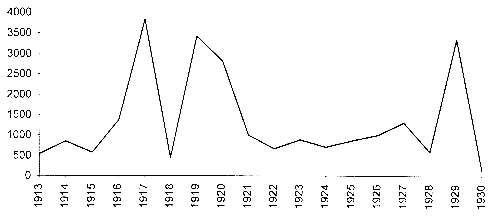
Chart 6b
Working Days Lost per 1000 Employees
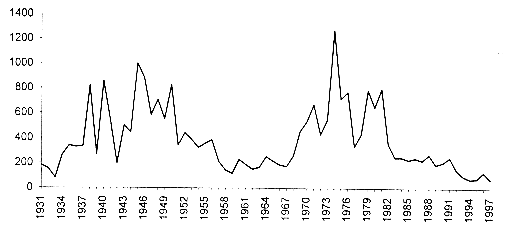
Source: Department of Workplace Relations. Note that the scale on 4b differs from that on 4a.
This has, in turn, created a risk-averse business culture that has given primacy to the notion that ‘trade unions are part of the system and we have to work within the system.’ The ‘body politic’ and the ‘body business’ have also generally adopted an accommodative response to aberrant union behaviour.
The AIRC retains a significant on-going role that leaves largely intact the conflict-resolution model of industrial relations. Prominent legal expert, Graeme Watson, recently reviewed the first 18 months of operation of the compliance provisions of the Workplace Relations Act and concluded that:
"Industrial action is occurring on a widespread basis with little interference from Courts and tribunals charged to ensure that it stop or not occur. These matters involve serious deficiencies in the fulfilment of the Coalition’s policy on illegitimate industrial action."
If employment agreements made provision for disputes resolution, that would be a better way of handling this difficult area.
Regulation And Economic Performance
What can be said about the relationship between Australia’s industrial relations institutional arrangements and economic performance? Some academics argue that, both in theory and in practice, there is little relationship. Even Australian business leaders sometimes point out that enterprises determined to improve their performance have generally been able to do so within the existing system. Several points need to be made.
First, Maddison’s analysis of historical growth trends shows that, from enjoying possibly the highest average living standard in the world when the compulsory conciliation and arbitration system was established in 1904, our relative position had slipped by 1994 to GDP per head being about 25 per cent below that for the US. Moreover, per head growth since 1950 has done no more than keep pace with the US and has fallen behind that for all the main European countries. We have not "converged" on the leader.
OECD data on GDP per head indicate some improvement in our relative performance in the most recent years and ABS data on multifactor productivity growth show a slight improvement since the last growth-cycle peak in 1988-89. However, the reforms since the late 1980s still leave relatively high unemployment rates and the employment rate is still a little below rates achieved in the early 1970s before the infamous wages surge.
Second, as Table 2 below shows, Australian productivity levels remain below those in most OECD countries and the labour productivity ‘gap’ relative to overseas countries has actually been widening. There are examples of substantial productivity gains by individual enterprises under the existing system but these highlight the costs and risks involved and the tendency for multinational enterprises with substantial resources to play a leading role.
Third, the response to argument that current institutional arrangements can be got around and, in practice, have little adverse economic effect one way or the other is surely - well, if that is so, there should be no objection to getting rid of them.
Fourth, some leading economic thinkers have, by contrast, concluded that institutional arrangements are a major factor in explaining differences in countries’ economic performances. As two-thirds of our increase in GDP per head reflects the unexplained residual of multi-factor productivity growth, the extent to which technology is actually applied is clearly heavily dependent on whether our institutional arrangements and policies encourage entrepreneurial behaviour.
Table 2
Comparative Levels of Labour Productivity and Employment (indices)
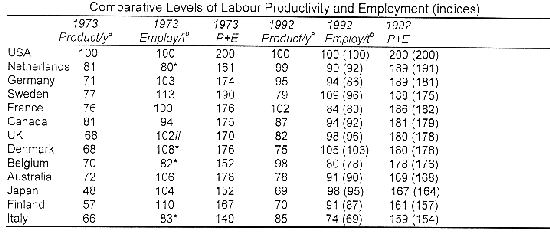
Notes: a:GDP per hour worked (US = 100). Source: A. Maddison, Monitoring The World Economy 1820-1992, Table 2-7(a),OECD Development Centre Studies, OECD, Paris, 1995.
b:Employment of 15-64 year olds to working age (15-64) population (US = 100). Source: OECD, Secretariat. Figures in brackets show the employment and overall rankings if 1997 data is used for employment.
*1983 data. #1984 data.
Fifth, alternative solutions to deregulation appear to have little merit. One is to increase the rate of economic growth through interventionist macro-economic policies so as to return to the 1950s and 1960s when unemployment averaged around 2.5 per cent. But such low unemployment occurred at a time of budget surpluses.
Equally, public sector spending was at least ten percentage points of GDP lower in the 1950s and 1960s than it is today. This suggests that high(er) public spending, and the higher taxation that goes with that, may be more a cause of high unemployment than a solution. Some government spending on labour market programs may have a role to play but it is more important to improve literacy standards through the education system, which does not require additional spending.
Current estimates of ‘structural’ unemployment of 7 per cent plus also suggest that structural reform is needed rather than increased public spending. Estimates indicating that slower or zero growth in real wages could lead to a significant permanent reduction in the unemployment rate point to the potential benefits from a more competitive labour market.
In any event, there is no evidence that achieving higher employment and lower unemployment are primarily dependent on higher economic growth per se. Moreover, while labour market reform should lead to improved productivity, that should not result in reductions in employment. As Table 2 shows, while some countries with high labour productivity have relatively poor employment performances, others do not. New Zealand’s productivity performance, which is not included in Table 2 because adequate comparable historical data is not available, has been subject to much criticism by distinguished academics on the ground that the economic and labour market reforms have not produced results. However, a recent analysis by the RBNZ (reflected in Chart 7) shows that, while trend productivity growth averaged just above zero pa from 1985 to 1991, it has since picked up to around 1 per cent pa compared with 0.6 per cent pa in the US
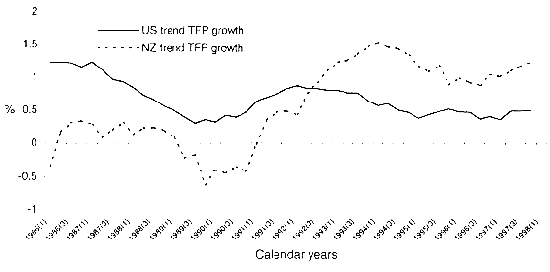
Conclusions
In conclusion, Australia’s labour market institutions and policies are probably an important explanator of our mediocre economic performance historically. Current relatively low productivity levels indicate the potential for improvement by reducing third party intervention in the labour market and "stimulating" productivity enhancing reforms.
Moreover, the risks from taking a deregulatory ‘plunge’ are minimal. The apparent relatively high literacy levels of the Australian work force at the bottom end make it unlikely that earnings dispersion under deregulation would widen as much as in some other less regulated markets. Anyhow, a widening in earnings dispersion would be offset by improvements in the efficiency and equity of existing arrangements, and in social benefits from deregulation. Any undesirable remnants of dispersion could be balanced through the social security system, which is the principal redistributive mechanism.